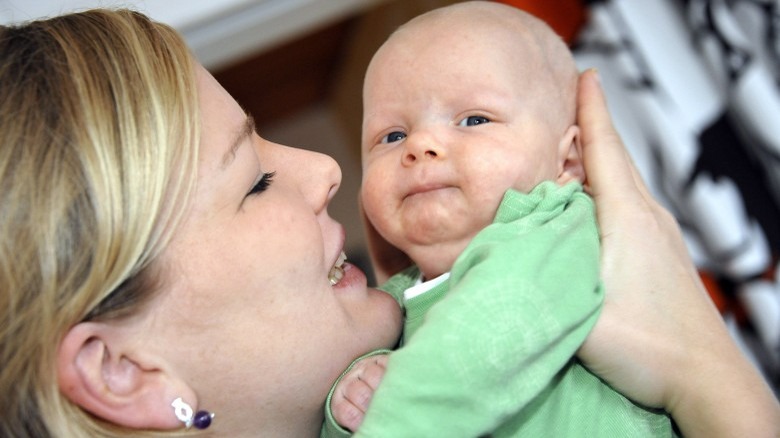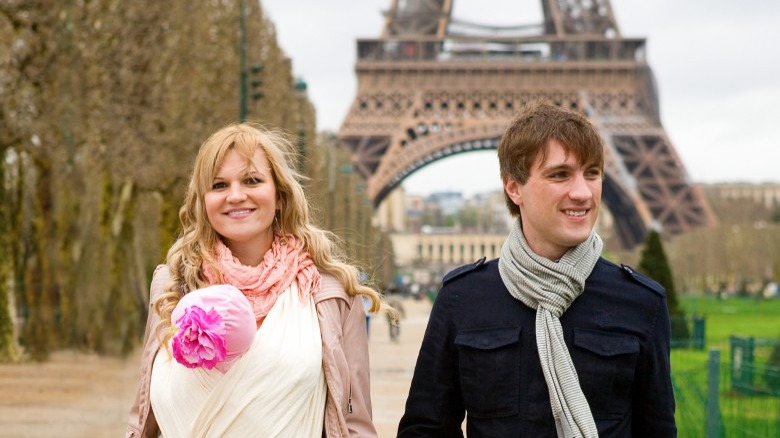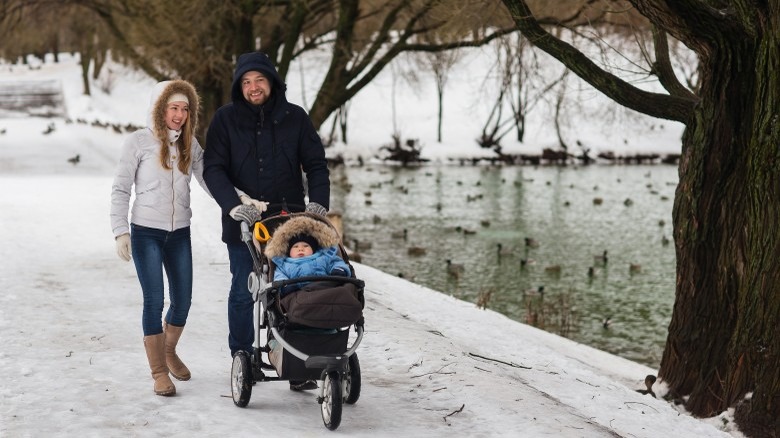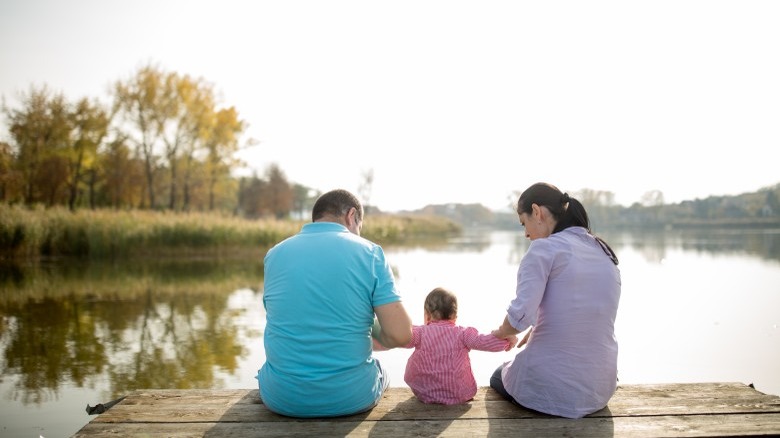Countries With New Parent Benefits Americans Won't Believe
Being a new parent is a thrilling, terrifying, and beautiful experience. Creating a life and nurturing, teaching, and loving your child is the most important job parents have, but they still need to keep their day jobs. Many families rely on dual income to provide the basic necessities and sustain a good standard of living for their families. So, it should go without saying that it can be pretty overwhelming for new parents to juggle these aspects of parenthood while managing their careers.
Out of the world's 196 countries, the United States, along with Lesotho, Liberia, Swaziland, and Papua New Guinea, are the only countries that have no federally mandated policy to give new parents paid time off, according to a study done by McGill University's Institute for Health and Social Policy.
Here are some countries around the world that are doing things right and prioritizing the well-being of new parents — giving them time to bond, enjoy, and get adjusted to their new role.
Iceland
On October 24, 1975, 90 percent of Icelandic women gathered on the streets of Reykjavik in an all-out professional and domestic strike to prove how indispensable they were. They didn't show up to work, they didn't make any meals or do any household chores, and they didn't even watch the children — and so the strike worked. Since then, Iceland has seen far-reaching progress for women and gender parity. In 2000, parental leave legislation came into effect, allowing every new parent, both Mom and Dad, three months paid leave that is non-transferable. After that parents have an additional three months to split up between them as they wish, equaling a total of nine months.
Parents continue to get 80 percent of their salary during their time off. Research has shown that 90 percent of Icelandic fathers take their paternal leave because they must use it or lose it completely. The impact of this is that women return to work quicker and fathers are more involved in childcare and do more housework after taking three months off with their children at the beginning. I didn't think I could love Iceland any more than I already do, but this is just another reason why.
Denmark
Being a new mom in Denmark means getting a total of 18 weeks off for maternity leave. This not only applies to giving birth, but for adoptions as well. Mothers get four weeks off before the birth and 14 weeks after, all at full pay, while fathers can take two consecutive weeks off during the 14 weeks. After that time period, both parents are given another 32 weeks of parental leave to split, and parents also have the option of extending the leave for an additional 14 weeks after that.
Thanks to the Danish Maternity Leave Act, parents get 52 weeks of paid leave from the government for each child. Parents are entitled to less than the full amount of their regular salary, but many Danish companies have an employee agreement already in place to pay your full salary for a set period of time.
Sweden
Sweden is the country with the longest paid parental leave, which tops out at 480 days. Each parent is entitled to 240 of the 480 days, and each parent has 90 days reserved only for him or her. During their parental leaves, employees are paid at 80 percent of their normal pay.
Parents can accumulate leave from several children, and the leave can be taken until a child turns eight years old. Outside of those 480 paid days, parents can also reduce their regular working hours by up to 25 percent, keeping in mind some adjusted pay. Think that's amazing? Get this: the government gives parents a monthly allowance for each child they have, until they turn 16, to go towards daycare or other community activities.
Hungary
In Hungary, mothers are entitled to 24 weeks of paid maternity leave at 70 percent of their regular salary. A mom can use this time for up to four weeks before her expected due date and then as much as she wishes afterwards. New fathers in Hungary get one week paid in full to be taken during the first two months of their child's life.
In total, though, moms can take up to three years off after childbirth. While they get 70 percent of their salary during maternity leave for the first six months, they can also receive up to 70 percent of their salary for the next 18 months they're off of work. However, the amount they receive during those 18 months is capped at 70 percent of double the minimum wage.
Finland
As an expectant mother in Finland, you can start your maternity leave seven weeks before the estimated due date. After that, 16 additional weeks of paid leave at up to 70 percent are covered by the government through a maternity grant. Fathers are also offered eight weeks of paid paternity leave.
Parents can also take parental or partial care leaves after the initial parental leave period is over. After a child turns three, moms and dads can take an unpaid leave to look after their child and are provided with a home care allowance to keep things running. This opportunity lasts until the child starts second grade.
France
In France, parental leave was reformed in 2014, allowing fathers to take more job-protected leaves and mothers to get back to work sooner. France offers employed mothers 16 weeks' paid maternity leave. They can take three to six weeks before the due date and then 10 to 13 afterwards; this increases in the cases of multiple births. Fathers are entitled to 11 days of paternity leave at their full salary. After that, parents are allowed 12 months of partially paid parental leave, but are required to split that time between them exactly in half.
On top of all of that, they have a program called "la rééducation périnéale," a series of government paid physical therapy sessions that aim to help new moms strengthen their pelvic floors and tighten their abs for their personal well-being and in preparation of any future births.
Estonia
A mother in Estonia is given 140 days of fully paid pregnancy and maternity leave. A new mom can begin her time off anywhere between 30-70 days before the expected delivery date. Like other Nordic countries, fathers in Estonia are given two weeks of paid time off; they can choose to take the time off during the two months before or after the baby arrives.
When maternity leave ends, parents can get an additional 435 days off to share for parental leave. Their compensation at this point is calculated by the average of their earnings. During the parental leave, the parent is paid a child care allowance for all of their children up until the age of three.
Belgium
In Belgium, mothers can take up to 15 weeks of maternity leave. During the first 30 days after their child is born, they get paid 80 percent of their salary, and then 75 percent for the remaining time off. Fathers can have 10 days off, with seven days paid at 82 percent of their salary, but only if they use them during the first four months of their baby's life.
Moms are also given the opportunity to take eight months of part-time leave instead of the 15 full weeks so they can still take on part-time hours at their workplace.
Norway
The Norwegians' parental leave system is statutory, but extremely flexible and generous. Together parents are allowed to take 49 weeks at full pay or 59 weeks at 80 percent pay. By law, mothers must take nine weeks off continuously before and after the birth of a child. Mothers must claim leave three weeks prior to their due date and then the first six weeks immediately after the birth.
The father is entitled to take two weeks paid leave when the baby is born and by law an additional 14 weeks of paid leave before the child turns three years old.
Lithuania
Most Nordic countries are known for their generous parental leave policies, but Lithuania might give them all a run for their money. It is mandatory that new moms get 18 weeks leave, while new dads get four weeks, and they both receive 100 percent fully paid leave during this time.
Together parents can get an additional 156 weeks to share, and they can decide whether to have it paid out at 100 percent until the child is turns a year old, or at 70 percent until the child is two years old.
Making progress
All of these countries may do things slightly differently, but they all have the same goal in common: supporting new parents and helping them keep their jobs. Many of the Nordic countries have set pretty high standards of expectations for parental leave benefits for both parents.
There are still many improvements to be made even in the world's most developed countries. In Canada, there are proposed changes to increase timing around maternity leave. The United States still only guarantees 12 weeks of unpaid time off, thanks to the Family and Medical Leave (FMLA) passed in 1993.
Many companies, like American Express and Etsy, are setting examples beyond what the legislature calls for. The furniture giant Ikea is taking a note from their Swedish homeland and providing increased benefits to their employees in places like India and the United States. According to research gathered by the World Economic Forum, there is evidence that maternity and paternity leave is actually better for the economy. In my mind, that means it's good for everyone.











